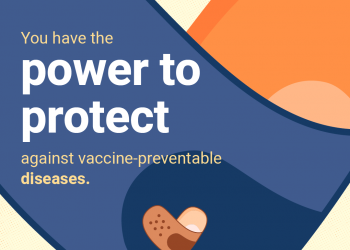August is National Immunization Awareness Month (NIAM) during which we highlight the importance of immunizations across the lifespan, as well as the need to get back on track with routine immunizations which have been impacted due to the COVID-19 pandemic.
As the nation continues to respond to COVID-19, uptake of the COVID-19 vaccine will continue to be vital in curbing the impact of the pandemic. Though many people have and will plan to be vaccinated against COVID-19, some have delayed vaccination due to concerns, questions, or other issues affecting their confidence in the COVID-19 vaccine. In effort to better address COVID-19 vaccine hesitancy and increase vaccine uptake, it is imperative to gain an in-depth understanding of the community and their COVID-19 vaccine needs. To assist health departments, coalitions, hospitals/clinics, and other organizations working to increase COVID-19 vaccine uptake, the Centers for Disease Control and Prevention developed the Rapid Community Assessment (RCA) Guide. The tool is used:
- To identify communities at risk for low COVID-19 vaccine uptake.
- To inform future phases of the COVID-19 vaccine rollout.
- To get an early understanding of what communities are thinking about COVID-19 vaccines and plan for potential solutions to increase confidence and uptake.
- To identify community leaders, trusted messengers, and other important channels through which you can reach communities.
- To identify areas of intervention and prioritize potential intervention strategies to increase confidence in and uptake of COVID-19 vaccine.
Local health departments (LHDs) are uniquely and ideally situated to conduct an assessment to better understand and respond to the COVID-19 vaccine needs of local communities. In April 2021, NACCHO queried a convenient sample of local health department (LHD) staff to inquire about their current efforts and future plans to engage individuals and communities to assess (formally or informally) their COVID-19 vaccine needs and/or the factors impacting their vaccination decisions. Participants responded to 24 questions regarding community demographics, the LHDs community assessment activities, assessment findings, and how results have been incorporated to guide their local COVID-19 vaccine response. 62 participants completed the assessment providing further insight into local COVID-19 vaccine efforts.
Key highlights from the assessment include:
- The majority (51%) of participants identified as serving rural communities. Additionally, 28% identified suburban, 17% urban and 4% frontier communities.
- Nearly half (46%) of respondents indicated that they have or are currently in the process of conducting a community assessment to inform COVID-19 vaccine efforts within the community. 27% of respondents have not yet, but plan to conduct a community assessment. 26% have not and do not plan to conduct a community assessment.
- LHD Community Assessment Findings: Several respondents indicated that their community assessment findings revealed that minority community members expressed significantly more concerns with vaccine safety than the ethnic majority community members. Though black, indigenous, and people of color (BIPOC) have been disproportionately impacted by COVID-19, many LHD assessments identified that COVID-19 vaccination acceptance has been lower among this community. Additionally, respondents shared that engagement with other partners and trusted community leaders have been instrumental in identifying and addressing barriers to vaccination among special populations. Examples of special populations mentioned included residents in senior living facilities, homebound individuals, incarcerated populations, and food processing and dairy farm workers.
- Using Community Assessments to Guide the LHD’s COVID-19 Vaccine Response: Many respondents indicated that results are being used to inform the creation of health equity task forces/groups aimed at ensuring equitable access to vaccine. Additionally, community assessments have been used to identify collaboration and partnership opportunities with community stakeholders and trusted leaders, increase access to COVID-19 vaccine via pop-up and mobile vaccine clinics or homebound vaccination services, as well as implement communication campaigns to share health education information or other culturally-tailored vaccine messaging.
- Barriers to completing a community assessment included staff capacity, time, funding resources and partner buy-in. Many respondents indicated that technical assistance in how to efficiently and effectively conduct a community assessment (templates, etc.) would be most valuable in helping LHDs conduct this important activity.
To further explore how LHDs are assessing their community’s COVID-19 vaccine needs and reaching priority populations, NACCHO conducted follow-up stakeholder interviews with two Minnesota LHDs – Goodhue County Health and Human Services and Polk Public Health. Read this Story from the Field, “Assessing Vaccine Hesitant Populations in Minnesota”, to receive lessons learned and other best practices of how these two LHDs are addressing COVID-19 vaccine hesitancy and used their community assessment to identify solutions to improve COVID-19 vaccine uptake.
For additional resources and information on conducting a Community Assessment to learn more about your community’s COVID-19 vaccine needs and decisions, visit the following resources:
- Vaccinate with Confidence: Strategy to Reinforce Confidence in COVID-19 Vaccines
- Rapid Community Assessment Guide





